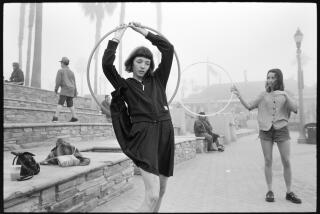A Breakthrough for the Breakers?
- Share via
In the dusty beach parking lot, the Don Quixote of the surf world opens the back doors of his rusty Ford van and pulls out a surfboard that looks like a giant bowling pin sliced down the middle.
“What is that?” asks a startled passerby at San Onofre State Beach.
Where does inventor Bob Howard start? He tosses out the surfboard’s name: the Flat Fish Noserider. He takes the gawker through the prototype’s bizarre design and enthusiastically explains why it allows a surfer to virtually camp out on the nose of the board, hangin’ 10. And he points to the beach where Josh Froley sits, telling the stranger that the pro surfer is intrigued by the potential and will be taking the board out for another test ride in a few minutes.
What doesn’t have to be said between the two wave riders is why this is all so important. They both have felt the ecstasy of standing on the nose of a board, zooming along a wave with nothing in front of them but a blue wall of water.
If Howard’s backyard invention can extend those moments by a few seconds--an eternity on a wave--the Flat Fish Noserider could join oversized tennis rackets, graphite-shafted golf clubs and aluminum baseball bats in revolutionizing a sport.
“We need this innovation to keep surfing alive and interesting,” said Tom Wegener, a well-known board shaper and surf-movie maker from California who now lives in Australia.
“The big manufacturers and shops hate and fear the backyard builders because they ... challenge their cushy, easy, relatively thoughtless existence,” Wegener said.
But the gap between unconventional genius and obsessed kook is admittedly thin, and at this point, not even the good-natured Howard is sure which side he falls on, eight years into his quest to revise standard surfboard design.
He is sure about one thing: He won’t stop, even with the maxed-out credit cards and snickers from the guys on the beach.
“My mind’s on fire,” says the 54-year-old Dana Point resident.Innovations in surf equipment have been made ever since Polynesians began catching waves with 175-pound planks of hardwood. But after the short board was introduced in the 1970s, radical assaults on the surfboard’s basic design have been few.
Huntington Beach’s Jeff “Doc” Lausch piqued surfers’ curiosity this year--he developed a fast short board by using a keel instead of fins, giving it the look of a stealth bomber. It’s called the Unidentified Surfing Object, or USO.
Howard, however, isn’t interested in speed--only in keeping a surfer’s toes on the nose. It’s the signature move, the slam-dunk, of long-boarding. The trick to hangin’ 10 is making the board’s tail stays in the water--not too easy when more than 150 pounds is standing on the nose. Usually, this can be done a few seconds at a time after the surfer maneuvers to the top of a breaking wave, where the cresting water pins down the back of the board.
Eight years ago, Howard began to tinker with ways to gain hang-10 time. A surfboard designer told him about the Coanda effect, a physics principle that says water or air will follow a curved surface, creating suction in the process. That suction creates lift for an airplane wing--and, Howard figured, could help hold down a surfboard so its rider could perch longer on the nose.
That was the idea behind his 1994 invention, the Koanda Noserider, a half-dome piece of fiberglass roughly the size of a small bicycle helmet that a fits over the surfboard’s fin to create a vacuum.
Howard got a marketing break that first year when long board legend Izzy Paskowitz used the Koanda to get a 16.5-second nose-ride in a Ventura contest. Other maverick surfers were also impressed.
“I was absolutely amazed by the way it worked,” Wegener said. “It hasn’t caught on because surfers are the most conservative people around and change is not smiled upon. The days of invention ended a quarter century ago.”
After seven tough years of marketing snafus, $6,000 in credit-card debt and a divorce, he put the device on the shelf, though it’s still available at his Web site (www.noseriding.com).
“I don’t drink, smoke or gamble,” says Howard, who makes a living writing employee newsletters for the Boeing Co. “I spent a few thousand dollars, but I had a million bucks’ worth of fun.”
Remarried and still obsessed with hangin’ 10, Howard got to thinking: Forget the attachments; why not design a nosing-riding surfboard from scratch? He created three miniature prototypes out of balsa wood last year and tested them in his special wind tunnel.
“I drove down Pacific Coast Highway at 60 mph and put my arm out the window with the boards,” he says. “I really got a feel of which design held down the tail.”
And he also ran a series of water tests last winter, when rains created ideal miniature surf conditions in the gutter outside his home.
The winner was the most radical design, which resembles a halibut more than a surfboard. Howard’s theory is that water will rush down the sides of the board and wash across the top of the tail, forcing down the back of the board.
Since Howard discovered he was “too fat and too old” to test his invention, he enlisted pro surfer Josh Froley three months ago as a test pilot.
“It nose-rides like crazy,” Froley says after a half-dozen surf sessions with the new board. “I almost blew off the back, it’s so fast.”
But the prototype has problems--mostly in its lack of maneuverability. After each test, Froley and Howard compare notes and make adjustments, including moving the fins away from the end of the board.
Howard still needs more test runs before he will try a revised design with a large, blank piece of foam that sits in his garage--the beginnings of his second prototype.
If the funky board becomes the new Hula Hoop for long-boarders, Howard says he’ll partner with a major surfboard manufacturer--but he’ll share his secrets with anyone.
“I don’t believe in patents in surfing,” he says. “It’s not in the spirit of surfing, which is about being one with nature and God.”
Tom Morey, creator of the Boogie Board and other surfing innovations, is familiar with Howard’s quest.
“Bob’s a heck of a nice guy, and somehow he’s gotten a fixation on making the world’s greatest nose-rider,” says Morey, a Dana Point resident. “That’s a nice goal, and I hope he does it.”
But Morey says if Howard’s creation works, it will raise a philosophical dilemma for long-boarders: “The question is: If you make something that everybody can ride right up on the tip of it, then what have you got? If it’s real easy, there is no goal.”
For surfers like Howard and Froley, the joy of wrapping their toes over the nose of a surfboard is a feeling everyone should experience. “It’s hard to explain if you haven’t done it,” Froley says.
“It’s like the water goes right up through you--you’re part of the ocean.”


